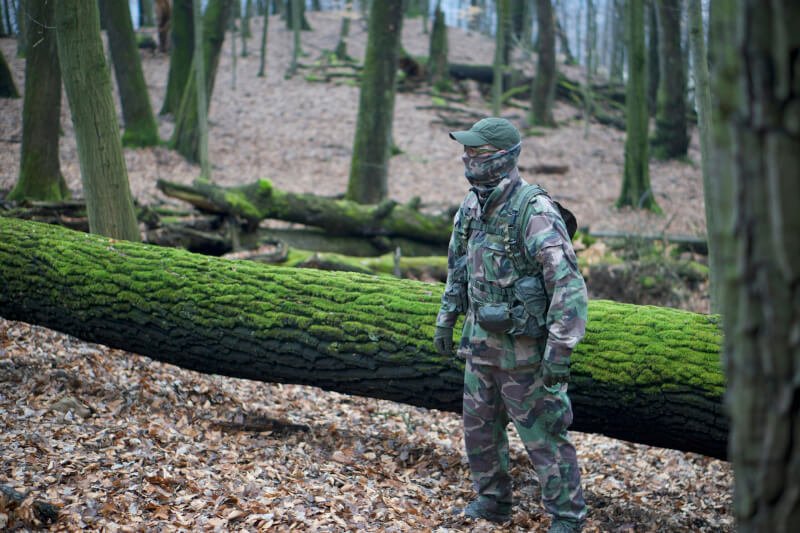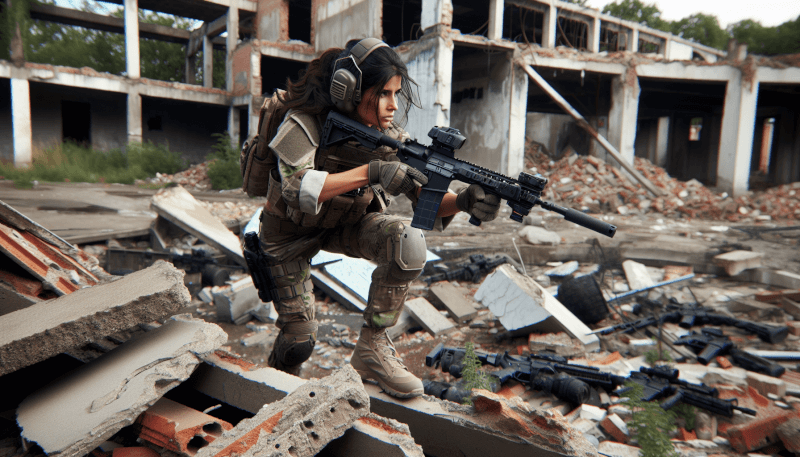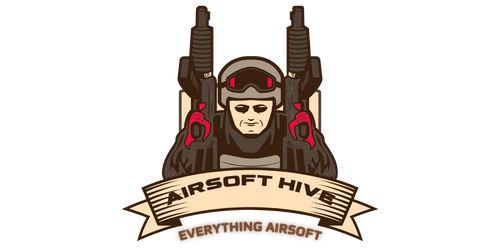Are you ready to take your airsoft skills to the next level? In this article, we will explore the exciting world of utilizing airsoft tactical maneuvers for offensive operations. Whether you’re a beginner looking to improve your gameplay or a seasoned veteran searching for new strategies, you’ll discover valuable insights and techniques that will enhance your performance on the field. From flanking maneuvers to suppressive fire tactics, we’ll cover it all. So grab your gear, lock and load, and get ready for an adrenaline-pumping adventure in the realm of airsoft warfare.

Understanding Airsoft Tactical Maneuvers
What is Airsoft?
Airsoft is a competitive team sport that simulates military or law enforcement scenarios using replica firearms that shoot non-lethal plastic pellets. It offers players a realistic combat experience without the actual dangers associated with real weapons. Airsoft games can take place indoors or outdoors, with various types of terrain, objectives, and gameplay styles. Tactical maneuvers play a crucial role in airsoft, especially when it comes to offensive operations.
Importance of Tactical Maneuvers in Airsoft
Tactical maneuvers are essential in airsoft as they enable players to outmaneuver and outsmart their opponents, effectively completing objectives and achieving victory. Without proper tactical execution, an offensive operation can quickly fall apart, resulting in failure. Good knowledge and application of tactical maneuvers not only enhance the gameplay experience but also promote teamwork, communication, and strategic thinking.
Offensive Operations in Airsoft
Offensive operations in airsoft generally involve attacking enemy positions and seizing objectives. It requires coordination, teamwork, and careful planning to overpower the opposing team effectively. Offensive maneuvers allow players to gain the upper hand, disrupt enemy lines, and create opportunities for victory. By studying and implementing effective offensive maneuvers, airsoft players can enhance their chances of success in the game.
Choosing and Adapting Tactical Maneuvers
Identifying the Objective
Before initiating any offensive operation, it is crucial to identify the objective clearly. Understanding what needs to be achieved enables players to plan and adapt their tactical maneuvers accordingly. Whether it is capturing a flag, rescuing hostages, or destroying a target, a well-defined objective provides a focus for the team and guides their strategic decision-making.
Analyzing the Terrain
The terrain plays a significant role in airsoft engagements and influences the choice of tactical maneuvers. Different terrains require different approaches, as they offer unique advantages and challenges. Analyzing the terrain allows players to identify potential cover, chokepoints, and areas of vulnerability. This information helps in determining the most effective and suitable tactical maneuvers for the situation.
Selecting Appropriate Maneuvers
Once the objective and terrain have been assessed, it is time to select the appropriate tactical maneuvers. There are various offensive maneuvers to choose from, each with its own advantages and considerations. Flanking, ambushing, suppressing fire, assaulting, breach and clear, hit-and-run, diversionary tactics, and creating crossfires are some of the commonly used offensive maneuvers in airsoft. Selecting the right maneuver depends on the team composition, enemy positions, and the overall strategy.
Adapting Maneuvers based on Situations
Flexibility and adaptability are vital in airsoft, as situations can change rapidly during gameplay. It is essential to be prepared to adjust tactical maneuvers based on evolving circumstances. Adapting to unexpected situations, such as changes in enemy position or unexpected defenses, is crucial for the success of offensive operations. Players must stay alert, communicate effectively, and be ready to modify their maneuvers to maintain the advantage.

Effective Offensive Maneuvers
Flanking
Flanking is a classic offensive maneuver that involves attacking the enemy from the sides or rear. This maneuver aims to catch the opponent off guard and create confusion within their ranks. By diverting their attention and forcing them to split their focus, flanking maneuvers can disrupt the enemy’s strategy significantly. It is crucial to coordinate with teammates, maintain stealth, and time the attack correctly to ensure a successful flank.
Ambushing
Ambushing is another effective offensive maneuver that involves setting up a trap for the enemy. Players lie in wait, concealed, until the ideal moment to strike. Ambushes work best in areas with limited visibility or natural bottlenecks, where players can catch their opponents by surprise. Patience, careful timing, and communication are essential to execute a successful ambush. Effective use of cover and minimal noise is crucial to maintain the element of surprise.
Suppressing Fire
Suppressing fire is a crucial offensive maneuver that aims to keep the enemy’s heads down and limit their movement. By laying down a barrage of continuous fire towards the enemy’s position, players force them to seek cover, reducing their ability to engage or defend effectively. This maneuver is particularly useful when advancing towards an objective, providing cover for teammates, or creating opportunities for flanking or assaulting. Strategic placement of suppressive fire is key to maintaining the advantage.
Assaulting
Assaulting is a direct and aggressive offensive maneuver that involves rapidly closing in on the enemy position to overwhelm and seize control. It requires superior firepower, speed, and coordination among teammates. Effective assaulting tactics involve providing cover fire, communicating movements, and utilizing teamwork to breach the enemy’s defense effectively. Timing is critical in assaults, and a well-coordinated effort increases the chances of success.
Breach and Clear
Breach and clear maneuvers are often used when the objective is located in a confined space, such as a building or room. This offensive tactic involves swiftly entering the area, neutralizing any threats, and securing the objective. Clear communication, proper room entry techniques, and coordination with teammates are essential for a successful breach and clear operation. Players should be cautious of potential enemy traps or ambushes within the confined space.
Hit-and-Run
Hit-and-run tactics involve quickly striking the enemy and retreating before they can mount an effective counterattack. This maneuver focuses on speed, surprise, and mobility. Hit-and-run attacks are often executed by small, highly mobile teams, allowing them to inflict damage on the enemy while minimizing the risk of being overwhelmed. Effective hit-and-run tactics involve careful planning, quick execution, and seamless disengagement.
Diversionary Tactics
Diversionary tactics involve creating a distraction or diversion to draw the enemy’s attention away from the main objective. This maneuver can deceive the enemy, making them believe that the diversion is the main attack while the real offensive is happening elsewhere. Diversionary tactics can be executed through the use of flares, noise distractions, or coordinated movements. Effective coordination and timing are vital for successful diversionary maneuvers.
Creating Crossfires
Creating crossfires is a tactical maneuver that involves positioning teammates to engage the enemy from multiple directions simultaneously. By surrounding the enemy or catching them in a crossfire, players can significantly increase their chances of success. Crossfires force the opposition to divide their attention and makes it difficult for them to focus on a single threat. Effective crossfires require clear communication, strategic positioning, and coordinated timing.
Coordinating Offensive Maneuvers
Communication and Signal Systems
Good communication is essential for coordinating offensive maneuvers effectively. Players must establish clear and concise communication channels, using hand signals, radio systems, or designated commands to relay information quickly and accurately. Effective communication ensures teammates are aware of the plan, coordinate their movements, and respond decisively to changing situations during offensive operations.
Establishing Roles and Responsibilities
Successful offensive operations require well-defined roles and responsibilities within the team. Each player should understand their specific role and how it contributes to the overall strategy. Whether it is providing cover fire, assaulting positions, or providing support, each team member’s role forms a crucial part of the offensive maneuver. Clear role assignments enhance coordination, streamline decision-making, and maximize the chances of success.
Executing Timing and Synchronization
Timing and synchronization are critical in offensive maneuvers. Coordinated movements between team members allow for seamless execution of offensive operations. Players need to practice timing their actions together, ensuring their movements align perfectly to overwhelm the enemy. Proper synchronization prevents confusion, minimizes the risk of friendly fire, and creates a cohesive force moving towards a common objective.
Covering Fire and Supporting Roles
Effective offensive maneuvers require the use of covering fire and supporting roles. Covering fire involves providing suppressive fire to keep the enemy’s heads down and limit their ability to engage effectively. Supporting roles can involve providing medical assistance, ammunition resupply, or flanking support. Proper use of covering fire and supporting roles ensures the success of offensive operations and the safety of the entire team.

Training and Practice for Offensive Operations
Developing Individual Skills
An essential aspect of effective offensive operations is the individual skills of each player. Regular training and practice sessions help develop these skills, including accuracy, target acquisition, movement techniques, and decision-making. Individual proficiency in handling weapons, navigating terrain, and reacting to changing situations is crucial for successful offensive maneuvers. Practicing these skills builds confidence, enhances overall performance, and improves the chances of success in airsoft games.
Small Unit Tactics
Small unit tactics involve training and coordination among a group of players who share specific objectives or roles. These tactics emphasize teamwork, communication, and the ability to move and operate as a cohesive unit. By practicing small unit tactics, players can refine their offensive maneuvers, learn to trust their teammates, and maximize the effectiveness of their actions. Regular drills and scenarios that simulate realistic combat scenarios are crucial for small unit tactical training.
Understanding Team Dynamics
Understanding team dynamics is essential for successful offensive maneuvers. Each player brings unique strengths, weaknesses, and capabilities to the team. Recognizing and leveraging these strengths effectively maximizes the team’s overall performance. Regular team-building exercises, communication training, and debriefing sessions help develop strong team dynamics. The better players understand each other’s abilities, the more effectively they can coordinate and launch offensive operations.
Simulating Realistic Scenarios
Simulating realistic scenarios is an effective way to prepare for offensive airsoft operations. Creating game scenarios that mimic real-world situations, such as hostage rescues, VIP protection, or urban warfare, allows players to practice their offensive maneuvers in a controlled environment. These simulations provide opportunities for players to understand the challenges, test different strategies, and make adjustments based on the outcomes. Simulations help players develop situational awareness, adaptability, and problem-solving skills.
Evaluating and Improving Performance
To continually improve offensive operations, players must evaluate their performance and identify areas of improvement. After gameplay sessions, conducting debriefings and analyzing the effectiveness of tactical maneuvers can provide valuable insights. Assessing individual and team performance, discussing successes and failures, and extracting lessons learned help refine tactics and strategies. Regular evaluation and improvement ensure that offensive operations become increasingly effective and successful.
Avoiding Common Mistakes
Lack of Communication
One of the most common mistakes in offensive airsoft operations is a lack of communication. Failure to communicate effectively leads to confusion, misunderstandings, and missed opportunities. Players must establish clear communication protocols and practice good communication habits during offensive maneuvers. Regularly checking in with teammates, relaying relevant information, and maintaining situational awareness through effective communication can prevent costly mistakes.
Poor Coordination
Poor coordination is another common mistake that can undermine offensive operations. Lack of coordination leads to disjointed, ineffective actions that can easily be countered by the enemy. Coordination requires practice, trust, and a clear understanding of teammates’ roles and responsibilities. Through training, drills, and regular teamwork, players can develop the necessary coordination skills to execute offensive maneuvers seamlessly and effectively.
Ignoring Safety Measures
Safety should always be a top priority in airsoft, even during offensive operations. Ignoring safety measures can result in accidents, injuries, or negative experiences for players. It is essential to wear proper safety gear, utilize protective eyewear, and follow field rules and regulations. Offensive maneuvers should be conducted with an emphasis on safe and responsible gameplay. Respect for fellow players’ well-being and adherence to safety guidelines enhance the overall airsoft experience.
Underestimating the Enemy
Underestimating the enemy is a critical mistake that can lead to failure in offensive operations. Assuming the opponent’s lack of skill or tactical insight can result in being outmaneuvered and defeated. Players should approach each engagement with respect for their opponents’ capabilities and constantly reassess their strategies and tactics. By maintaining a realistic perspective and adapting to the enemy’s actions, players can better anticipate and counter their moves, increasing their chances of success.
Failure to Adapt to Changing Situations
Airsoft gameplay is dynamic, and situations can change rapidly. Failing to adapt to changing circumstances can put offensive operations at a disadvantage. Players must remain flexible, constantly assess the situation, and be ready to adjust tactics and maneuvers accordingly. Rigidity and a refusal to adapt to unexpected developments can lead to missed opportunities or being caught off guard by the enemy. Adapting quickly to changing situations ensures the continuous momentum of offensive operations.

Utilizing Equipment and Gear for Offensive Operations
Choosing Suitable Weapons
Selecting suitable weapons is critical for offensive operations in airsoft. Players should consider factors such as range, accuracy, rate of fire, and maneuverability when choosing their primary or secondary weapon. Different offensive maneuvers may require different types of firearms, such as rifles for suppressive fire, compact submachine guns for close-quarters combat, or designated marksman rifles for precision engagements. Understanding the strengths and limitations of different weapons allows players to make informed choices and maximize their effectiveness in offensive situations.
Utilizing Optics and Attachments
Optics and attachments can greatly enhance the capabilities of airsoft weapons in offensive operations. Red dot sights, holographic sights, magnifiers, and scopes provide improved aiming and target acquisition capabilities, especially at longer ranges. Attachments such as flashlights, laser sights, foregrips, and suppressors can improve weapon handling, maneuverability, and stealth. By selecting and utilizing appropriate optics and attachments, players can gain a tactical advantage, enhancing their offensive maneuvers.
Using Tactical Gear and Loadouts
Tactical gear and loadouts play a significant role in offensive operations. Players should select gear that allows them to carry essential equipment comfortably while providing protection and functionality. Loadouts can be tailored to meet specific offensive objectives, such as carrying extra ammunition, grenades, or tools for breaching and clearing. Properly having and utilizing tactical gear ensures players are prepared for various situations, enhances their mobility, and streamlines their offensive operations.
Strategies for Different Environments
Urban Environments
In urban environments, offensive operations require adaptation to the unique challenges posed by buildings, streets, and limited lines of sight. Maneuvers such as building clearing, room entry, and close-quarters battle tactics become crucial. Effective communication, coordination, and swift movement are essential for success in this environment. Utilizing cover, employing suppressing fire, and implementing diversionary tactics can help overcome the difficulties of urban warfare.
Woodland and Forest Areas
Woodland and forest areas offer a different set of challenges for offensive operations. Maneuvering through dense vegetation, avoiding detection, and maintaining situational awareness become key factors. Strategic flanking, effective camouflage, and careful movement help gain the advantage in woodland environments. Utilizing the natural terrain, creating ambush sites, and conducting hit-and-run tactics can maximize the team’s offensive potential in these areas.
Desert and Arid Terrains
Desert and arid terrains present their own challenges for offensive operations. Wide-open spaces, limited cover, and extreme temperatures require unique tactics. Patience, long-range engagements, and careful movement play a significant role in desert warfare. Effective use of suppressive fire, coordination in open terrain, and utilizing decoys or diversionary tactics can exploit weaknesses and create opportunities for success in desert environments.
Indoor CQB (Close Quarters Battle)
Indoor CQB environments demand quick thinking, rapid movement, and the ability to engage targets in confined spaces. Offensive operations in indoor settings require specialized tactics such as room clearing, door breaching, and rapid target acquisition. Teamwork, communication, and situational awareness are crucial in CQB scenarios. Utilizing flashbangs, smoke grenades, and optimizing weapon configurations for close-quarters engagements enhance the effectiveness of offensive maneuvers in indoor environments.

Taking Advantage of Team Synergy
Utilizing Specialized Roles
Specialized roles within a team contribute to overall effectiveness in offensive airsoft operations. Roles such as designated marksmen, medics, support gunners, and grenadiers provide unique capabilities that can be leveraged during offensive maneuvers. By utilizing specialized roles, a team can maximize its offensive potential. Each role has specific responsibilities, equipment, and training requirements that contribute to the overall synergy and success of offensive operations.
Teamwork and Cooperation
Teamwork and cooperation are paramount in offensive airsoft operations. A cohesive team that communicates effectively, supports each other, and coordinates their actions can overcome even the most challenging objectives. Trust, reliance, and mutual respect among teammates build a strong foundation for effective teamwork. By working together, players can complement each other’s strengths, cover each other’s weaknesses, and create a formidable force that is difficult for the enemy to overcome.
Using Combined Arms Strategies
Combined arms strategies involve utilizing different types of weaponry, gear, and tactics together in a coordinated manner. This approach combines the strengths of various assets, such as infantry, support gunners, designated marksmen, and grenadiers, to maximize offensive potential. Combined arms strategies require effective coordination, communication, and synchronization among team members. This approach allows players to have a well-rounded offensive force capable of tackling various challenges and scenarios.
Conclusion and Practical Application
Reviewing the Importance of Offensive Operations
Offensive operations play a crucial role in airsoft, allowing teams to gain the advantage, complete objectives, and achieve victory. Understanding and effectively utilizing tactical maneuvers are essential for success in offensive airsoft gameplay. Through careful planning, proper coordination, and adaptation to changing situations, players can overcome challenges and outmaneuver their opponents.
Implementing Tactical Maneuvers in Airsoft Games
To implement tactical maneuvers effectively in airsoft games, players must invest time in training, practice, and strategic thinking. Regular drills, scenario simulations, and coordination exercises enable players to refine their skills, develop teamwork, and enhance their ability to execute offensive operations. Learning from mistakes and evaluating performance allows for continual improvement and increased success in airsoft games.
Continual Learning and Improvement
Learning and improvement are ongoing processes in airsoft. Implementing tactical maneuvers requires a commitment to learning, practicing, and adapting to new strategies and techniques. Staying up-to-date with current tactics, studying other players’ gameplay, and seeking feedback contribute to continual growth. By embracing a mindset of continual learning and improvement, airsoft players can continually enhance their offensive maneuvers, stay ahead of the competition, and enjoy the challenges and rewards of the sport.


